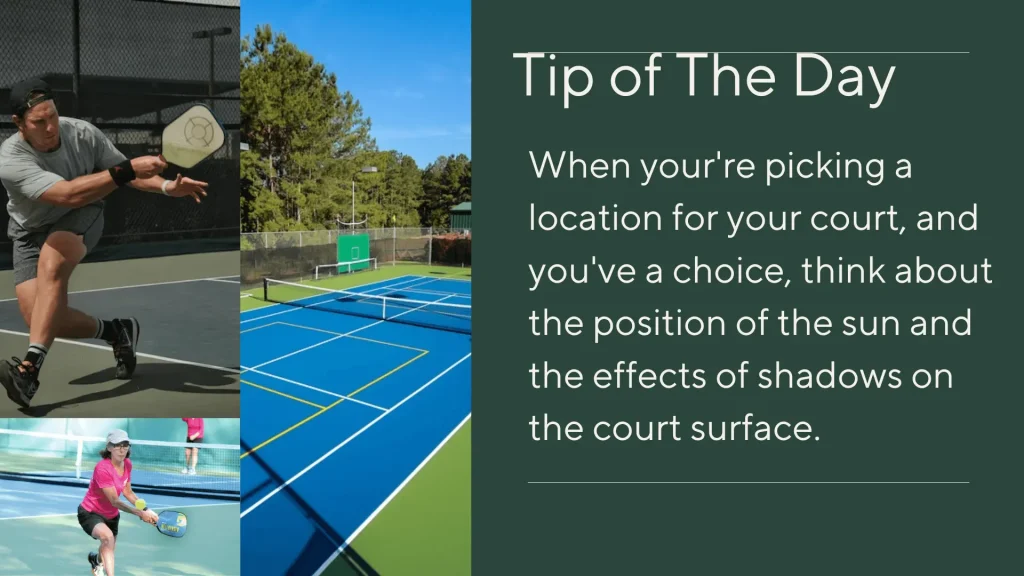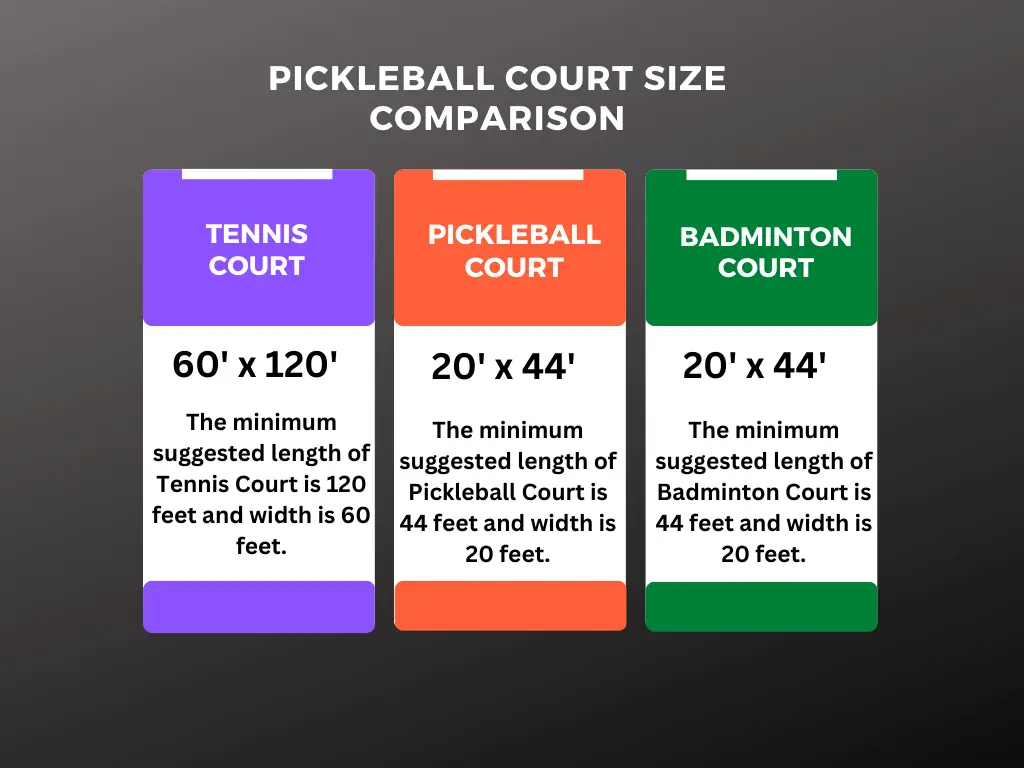From Pickleball Court Dimensions To Construction- How I Saved $5000 Easily

Are you ready to elevate your pickleball skills? Discover the secrets of pickleball court dimensions backyard or elsewhere and create the perfect playing area for maximum enjoyment.
This user-friendly guide provides simple instructions on court length, width, and net height, empowering you to set up a pickleball court that takes your game to the next level.
Whether you’re a beginner or an avid player, understanding pickleball court dimensions ensures fair play and optimal performance. Dive into this guide and unlock the key to constructing a well-designed court that enhances your pickleball experience. Get ready to transform your game and embrace the excitement of pickleball like never before!
Suppose you have decided to build an outdoor pickleball court for your home, recreation center, club, or school and worry about where to begin setting up a pickleball court. Before setting up a court, pickleball court dimensions should be in our minds. The techniques for constructing pickleball are the same as the tennis court.
What are the Pickleball Court Dimensions and How Big is a Pickleball Court?
Before setting up, you should know how big a pickleball court is and its dimensions. Compared to doubles badminton courts, the pickleball court’s dimensions and measurements in feet are 20 x 44 and its dimensions in meters are (6.096 X 13.4112). The Pickleball court dimensions half is approximately 10 feet in width and 22 feet in length. In pickleball, singles and doubles games are played on the same courts. There must be 36 inches of net height on the sides of the pickleball court and 34 inches at the center. Its court dimensions are the same whether the court is indoor or outdoor.
The court is marked like a tennis court with a right and left service area of the court and 7 7-foot non-volley zone, the kitchen on both sides of the net. In court construction, you’ve got a choice whether you specifically want a pickleball court or want to convert it into multiple courts for playing tennis and badminton.
If you’re a pickleball coach at school or a country club, a senior living community, or a beginner, following guidelines will help you understand what a pickleball court’s dimensions are and how we can construct it. These are the basic guidelines for building a pickleball court.

STEP 1: DETERMINE YOUR SPACE | Pickleball Court Dimensions vs. Tennis
Is this your first pickleball court? Knowing the pickleball court dimensions is very important. Do you want to build a multi-court complex, or do you wish to convert a tennis or badminton court? These are the key questions before starting the court. You’ve to move forward according to your needs.
For instance, if you desire to use a tennis court for playing pickleball, pickleball court dimensions on tennis court estimates as it can be divided into four pickleball courts easily, and many players can play on these four courts. Pickleball systems with multiple courts have the same overall construction and dimensions as single courts. The only difference is that each pickleball court must have its padded fence.
Pickleball Court Dimensions vs. Volleyball Court
Pickleball courts feature smaller dimensions when compared to volleyball courts. In terms of size, a standard pickleball court spans 20 feet in width and 44 feet in length, while a volleyball court boasts significantly larger dimensions, measuring 30 feet by 60 feet.
The smaller dimensions of a pickleball court make it more suitable for players who prefer a smaller playing area and a slower-paced game, while a volleyball court provides more space for players to move around and engage in a faster-paced sport.
What are the Pickleball Court Dimensions Singles or Doubles?
There should be standard pickleball court dimensions of 20 by 44 feet and in meters(6.096 X 13.4112) for both formats, singles, and doubles play.
Height of Net
There should be the following the standard height of a pickleball net sidelines 36 inches and the middle 34 inches.
Pickleball Playing Area
When you’re selecting a tennis court, by 30*60 feet, but 34* 64 feet is preferable for tournament play or if you’ll have a stand-alone pickleball court.
STEP 2: SELECTION OF COURT SURFACE MATERIALS
If you intend to build your outdoor pickleball court from scratch or want the existing court that needs to be revamped, you should know what is the best court surface for you. You should select the pickleball court surface that is best for you. Common and ordinary types of court surface materials for pickleball include the following:-
Concrete
As far as durability and value are concerned, this type of surface is the best for outdoor courts.
Asphalt
This will be the best option if you want a more affordable way; however, it may require more maintenance.
Snap-Together Plastic
You can apply snap-together surfaces over asphalt or concrete when you don’t want to alter the upper side of a multi-purpose court permanently.

STEP 3: PICK OUT PERIMETER FENCING
Fencing has a vital role in multi-court pickleball courts as it provides security for players and spectators of the game during play. There are multiple types of pickleball court fencing to opt for, but wire fences are the most common as they permit the picklers and spectators to see into and outside the court.
These fences allow light to pass through easily. An experienced contractor of pickleball courts can assist you in choosing and accurately installing pickleball fences. Remember that these are covered with rust-resistant material to keep players safe and sound from injury.
Pickleball Court Dimensions With Fence
It is recommended that there should be 10 feet(3.048 meters) height, preferably, but 4 feet(1.2192 meters) is better as long as the top of the fence is padded.
STEP 4: PROPER ARRANGMENTS OF LIGHT FOR THE COURT
If we want to play this game at night, there’s a need for proper light arrangements for your pickleball court. For lighting the pickleball court, we should obey standard protocol. There should be two 1,500-watt light poles in the pickleball court. Keep in mind that each light rod’s height should be between 18 to 20 feet and installed in the center of the court, at least 24 inches back from the court.
STEP 5: SHOP PICKLEBALL NET SYSTEMS
After the process of choosing your space, surface, and court materials, getting advice from an expert to help you search for the right and suitable pickleball net for your program is the next logical step. There are serval types of pickleball poles and systems to opt from, and all have different qualities. However, outdoor pickleball poles are specifically designed to withstand the elements. A complete outdoor pickleball net system requires the following:
- Two poles
- One ratchet
- One outdoor pickleball net
- Sleeves (optional)
STEP 6: UNIQUE TIPS FOR THE PICKLEBALL COURT BUILDING PROCESS
When you complete the process of choosing the pickleball surface, fencing, lighting, and other materials are chosen, it’s time to put them all together. The following 12 unique tips can aid you in the building process. Court lines must be white and 2 inches wide. To draw marker lines, use sidewalk chalk, the contractor’s blue #1 chalk dust, green tape, orange masking tape, or acrylic paint. There should be standard lines according to USA Pickleball, for a pickleball court consist of the following:
Always Hire a Professional Contractor
While establishing a pickleball net system may be easy if you’re putting a court net and painting the surface for just one court for your yard, always hire a professional contractor to ensure everything is constructed and set up to code for recreation centers, clubs, and school pickleball play.
The Direction of The Court
Keep in mind that your court direction is recommended north-south. It’s very important to orient your pickleball court north-south to avoid obstructing the players’ vision due to environmental factors (position of the sun, shadows cast on the court surface, etc.).
Baselines
These lines go side by side to the pickleball net on both court ends.
Sidelines
These lines mark at right angles the pickleball net on either side of the courtyard.
Non-Volley Line
These lines are also called kitchen lines on both sides of the net, 7 feet from the net and between the sidelines, running parallel to the net.
Non-Volley Zones (The Kitchen)
These areas of the pickleball yard are surrounded by two secondary lines, the non-volley line and the net.
Centerlines
Situated on each side of the net, between the volley line and the baseline.
Service Area of Courts
These specific areas run on both sides of the center, surrounded by a non-volley zone line, known as the kitchen line, sideline, and baseline.
Enough Space Around the Court
Make sure there should be enough space around the court to allow for a good out-of-bounds area. Try to have somewhere between 5 and 14 feet behind the court baseline and to both sides.
If there’s a small space things will start to get tight. Experienced players will use more space well; it’s. Therefore, there should be appropriate space.
The Idea of Converting the Tennis Court
The idea of converting the tennis courts is good and will permit you to build 4 well-sized pickleball courts inside the tennis court footprint.
Pickleball Multi-Court Facility
A pickleball multi-court facility is a better idea, then ideally, pickleball fencing should surround the complete court, and there should be adequate padding between each court.
Permission Before Erecting Lights
You’ve to seek due permission before erecting lights in the courts from your neighbors to enhance playing timings by neighbors. You should take care of residential areas. You’ll also require the necessary permission before proceeding with construction.
Selection of Surface
Select a reasonable hard surface free of bumps and holes if you wish to mark out a DIY pickleball court. Always avoid grass and clay, as the pickleball won’t bounce much. Pickleballs are unlike tennis balls. They are made of perforated plastic like a waffle ball and don’t bounce very high on grass and clay surfaces.
Use of Moveable Nets
Moveable nets are fit for casual games on temporary courts.
The Benefit of Fencing Around the Court
It is good to have fencing around your pickleball court if it’s outdoors if space allows. This way, you won’t be chasing balls all over the place when they go out of bounds.
Ideal and Perfect Court
The ideal and perfect surface materials for permanent pickleball courts are smooth concrete painted with polyurethane or an acrylic coating.
Use of Other Game Courts
Under-utilized basketball, tennis, or badminton courts are ideal candidates for conversion into multiple pickleball courts. You naturally need permission from the owners before marking the surface.
Conclusion
Lastly, everyone should follow the guidelines described by USA Pickleball Association to ensure quality and standards as defined. Pickleball court dimensions are a very serious topic. According to USAPA, an official pickleball court dimensions should be 20 x 44 feet. After this process, you only need a portable net, paddles, and a ball with holes to play.
However, with the game’s growth, there’s a need of the day to increase more and more pickleball courts in our area.
If you need a dedicated pickleball court in your area, you can create a makeshift one. You only require colorful tape to draw out the lines and a net. If you desire to build an outdoor pickleball court, keep in mind that you should use just about any hard material for your court surface.
However, mixing concrete with rubber polyurethane or acrylic surfacing is ideal and suitable. To accommodate wheelchairs, players can also participate in this fastest-growing and popular game with friends and family. A pickleball wheelchair court is much bigger than a traditional one to give players more space to move around. The size dimensions for wheelchair pickleball are 44 x 74 feet long.
